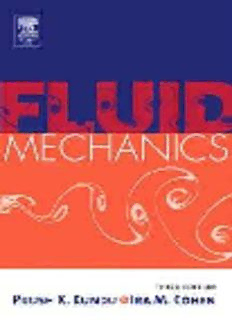Table Of ContentFluid Mechanics, Third Edition
Founders of Modern Fluid Dynamics
LudwigPrandtl G.I.Taylor
(1875–1953) (1886–1975)
(BiographicalsketchesofPrandtlandTayloraregiveninAppendixC.)
PhotographofLudwigPrandtlisreprintedwithpermissionfromtheAnnualReviewofFluid
Mechanics,Vol.19,Copyright1987byAnnualReviewswww.AnnualReviews.org.
PhotographofGeoffreyIngramTayloratage69inhislaboratoryreprintedwithpermission
fromtheAIPEmilioSegre`VisualArchieves.Copyright,AmericanInstituteofPhysics,2000.
Fluid Mechanics
Third Edition
Pijush K. Kundu
OceanographicCenter
NovaUniversity
Dania,Florida
Ira M. Cohen
DepartmentofMechanicalEngineeringand
AppliedMechanics
UniversityofPennsylvania
Philadelphia,Pennsylvania
withachapteronComputationalFluidDynamicsbyHowardH.Hu
AMSTERDAM (cid:1) BOSTON (cid:1) HEIDELBERG (cid:1) LONDON
NEW YORK (cid:1) OXFORD (cid:1) PARIS (cid:1) SAN DIEGO
SAN FRANCISCO (cid:1) SINGAPORE (cid:1) SYDNEY (cid:1) TOKYO
ElsevierAcademicPress
525BStreet,Suite1900,SanDiego,California92101-4495,USA
84Theobald’sRoad,LondonWC1X8RR,UK
Thisbookisprintedonacid-freepaper.(cid:1)
∞
Copyright©2004,ElsevierInc.Allrightsreserved.
Nopartofthispublicationmaybereproducedortransmittedinanyformorbyany
means,electronicormechanical,includingphotocopy,recording,oranyinformation
storageandretrievalsystem,withoutpermissioninwritingfromthepublisher.
PermissionsmaybesoughtdirectlyfromElsevier’sScience&TechnologyRights
DepartmentinOxford,UK:phone:(+44)1865843830,fax:(+44)1865853333,
e-mail:permissions@elsevier.com.uk.Youmayalsocompleteyourrequeston-linevia
theElsevierhomepage(http://elsevier.com),byselecting“CustomerSupport”
andthen“ObtainingPermissions.”
LibraryofCongressCataloging-in-PublicationData
AcataloguerecordforthisbookisavailablefromtheLibraryofCongress
BritishLibraryCataloguinginPublicationData
AcataloguerecordforthisbookisavailablefromtheBritishLibrary
ISBN 0-12-178253-0
ForallinformationonallAcademicPresspublications
visitourWebsiteatwww.academicpress.com
PrintedintheUnitedStatesofAmerica
04 05 06 07 08 9 8 7 6 5 4 3 2 1
ThethirdeditionisdedicatedtothememoryofPijushK.Kunduandalsotomywife
LindaanddaughtersSusanandNancywhohavegreatlyenrichedmylife.
“Everythingshouldbemadeassimpleaspossible,
butnotsimpler.”
—AlbertEinstein
“Ifnaturewerenotbeautiful,itwouldnotbeworthstudyingit.
Andlifewouldnotbeworthliving.”
—HenryPoincare´
In memory of Pijush Kundu
Pijush Kanti Kundu was born in Calcutta,
India, on October 31, 1941. He received a
B.S. degree in Mechanical Engineering in
1963 from Shibpur Engineering College of
Calcutta University, earned an M.S. degree
in Engineering from Roorkee University in
1965,andwasalecturerinMechanicalEngi-
neeringattheIndianInstituteofTechnology
in Delhi from 1965 to 1968. Pijush came to
the United States in 1968, as a doctoral stu-
dent at Penn State University.With Dr. John
L.Lumleyashisadvisor,hestudiedinstabili-
tiesofviscoelasticfluids,receivinghisdoctor-
atein1972.Hebeganhislifelonginterestin
oceanographysoonafterhisgraduation,workingasResearchAssociateinOceanog-
raphyatOregonStateUniversityfrom1968until1972.Afterspendingayearatthe
UniversitydeOrienteinVenezuela,hejoinedthefacultyoftheOceanographicCenter
ofNovaSoutheasternUniversity,whereheremaineduntilhisdeathin1994.
Duringhiscareer,Pijushcontributedtoanumberofsub-disciplinesinphysical
oceanography,mostnotablyinthefieldsofcoastaldynamics,mixed-layerphysics,
internal waves, and Indian-Ocean dynamics. He was a skilled data analyst, and, in
thisregard,oneofhisaccomplishmentswastointroducethe“empiricalorthogonal
eigenfunction”statisticaltechniquetotheoceanographiccommunity.
IarrivedatNovaSoutheasternUniversityshortlyafterPijush,andheandIworked
closelytogetherthereafter.Iwasimmediatelyimpressedwiththeclarityofhisscien-
tificthinkingandhisthoroughness.Hismostimpressiveandobviousquality,though,
was his love of science, which pervaded all his activities. Some time after we met,
Pijush opened a drawer in a desk in his home office, showing me drafts of several
chapters to a book he had always wanted to write.A decade later, this manuscript
becamethefirsteditionof“FluidMechanics,”theculminationofhislifelongdream;
which he dedicated to the memory of his mother, and to his wife Shikha, daughter
Tonushree,andsonJoydip.
JulianP.McCreary,Jr.,
UniversityofHawaii
Contents
Preface ................................................... xvii
PrefacetoSecondEdition ................................. xviii
PrefacetoFirstEdition ..................................... xx
Author’sNotes ........................................... xxiii
Chapter 1
Introduction
1. FluidMechanics.............................................. 1
2. UnitsofMeasurement......................................... 2
3. Solids,Liquids,andGases..................................... 3
4. ContinuumHypothesis........................................ 4
5. TransportPhenomena......................................... 5
6. SurfaceTension .............................................. 8
7. FluidStatics ................................................. 9
8. ClassicalThermodynamics .................................... 12
9. PerfectGas .................................................. 16
10. StaticEquilibriumofaCompressibleMedium................... 17
Exercises .................................................... 22
LiteratureCited .............................................. 23
SupplementalReading ........................................ 23
Chapter 2
Cartesian Tensors
1. ScalarsandVectors ........................................... 24
2. RotationofAxes:FormalDefinitionofaVector.................. 25
vii
viii Contents
3. MultiplicationofMatrices..................................... 28
4. Second-OrderTensor ......................................... 29
5. ContractionandMultiplication................................. 31
6. ForceonaSurface............................................ 32
7. KroneckerDeltaandAlternatingTensor......................... 35
8. DotProduct.................................................. 36
9. CrossProduct ................................................ 36
10. Operator :Gradient,Divergence,andCurl..................... 37
∇
11. SymmetricandAntisymmetricTensors ......................... 38
12. EigenvaluesandEigenvectorsofaSymmetricTensor............. 40
13. Gauss’Theorem.............................................. 42
14. Stokes’Theorem.............................................. 45
15. CommaNotation ............................................. 46
16. BoldfacevsIndicialNotation .................................. 47
Exercises .................................................... 47
LiteratureCited .............................................. 49
SupplementalReading ........................................ 49
Chapter 3
Kinematics
1. Introduction.................................................. 50
2. LagrangianandEulerianSpecifications ......................... 51
3. EulerianandLagrangianDescriptions:TheParticleDerivative .... 53
4. Streamline,PathLine,andStreakLine.......................... 54
5. ReferenceFrameandStreamlinePattern ........................ 56
6. LinearStrainRate ............................................ 57
7. ShearStrainRate............................................. 58
8. VorticityandCirculation ...................................... 59
9. RelativeMotionnearaPoint:PrincipalAxes .................... 61
10. KinematicConsiderationsofParallelShearFlows................ 64
11. KinematicConsiderationsofVortexFlows ...................... 65
12. One-,Two-,andThree-DimensionalFlows...................... 68
13. TheStreamfunction........................................... 69
14. PolarCoordinates............................................. 72
Exercises .................................................... 73
SupplementalReading ........................................ 75
Contents ix
Chapter 4
Conservation Laws
1. Introduction.................................................. 77
2. TimeDerivativesofVolumeIntegrals........................... 77
3. ConservationofMass......................................... 79
4. Streamfunctions:RevisitedandGeneralized..................... 81
5. OriginofForcesinFluid ...................................... 82
6. StressataPoint .............................................. 84
7. ConservationofMomentum ................................... 86
8. MomentumPrincipleforaFixedVolume........................ 88
9. AngularMomentumPrincipleforaFixedVolume................ 92
10. ConstitutiveEquationforNewtonianFluid ...................... 94
11. Navier–StokesEquation....................................... 97
12. RotatingFrame............................................... 99
13. MechanicalEnergyEquation .................................. 104
14. FirstLawofThermodynamics:ThermalEnergyEquation......... 108
15. SecondLawofThermodynamics:EntropyProduction............ 109
16. BernoulliEquation............................................ 110
17. ApplicationsofBernoulli’sEquation............................ 114
18. BoussinesqApproximation .................................... 117
19. BoundaryConditions ......................................... 121
Exercises .................................................... 126
LiteratureCited .............................................. 128
SupplementalReading ........................................ 128
Chapter 5
Vorticity Dynamics
1. Introduction.................................................. 129
2. VortexLinesandVortexTubes ................................. 130
3. RoleofViscosityinRotationalandIrrotationalVortices .......... 130
4. Kelvin’sCirculationTheorem.................................. 134
5. VorticityEquationinaNonrotatingFrame....................... 138
6. VelocityInducedbyaVortexFilament:LawofBiotandSavart. ... 140
7. VorticityEquationinaRotatingFrame.......................... 141
8. InteractionofVortices......................................... 146
9. VortexSheet ................................................. 149
Exercises .................................................... 150
Description:Fluid Mechanics, understanding and applying the principles of how motions and forces act upon fluids such as gases and liquids, is introduced and comprehensively covered in this widely adopted text. New to this third edition are expanded coverage of such important topics as surface boundary interfac

